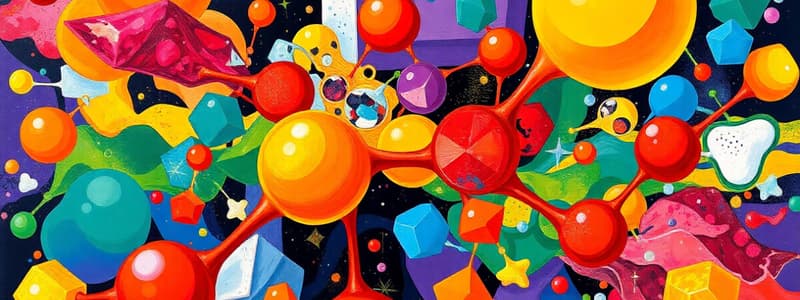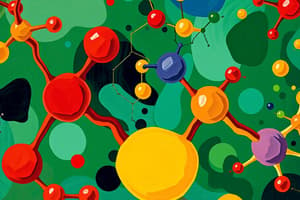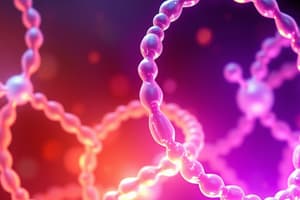Podcast
Questions and Answers
If an astronaut travels to a planet with significantly less gravity than Earth, which statement is true?
If an astronaut travels to a planet with significantly less gravity than Earth, which statement is true?
- Both the astronaut's mass and weight will decrease proportionally.
- Both the astronaut's mass and weight will increase. (correct)
- The astronaut's weight will decrease, but their mass will remain the same.
- The astronaut's mass will decrease, but their weight will remain the same.
Which of the following correctly lists the states of matter from least to most definite shape and volume?
Which of the following correctly lists the states of matter from least to most definite shape and volume?
- Gas, liquid, solid
- Solid, liquid, gas (correct)
- Liquid, gas, solid
- Gas, solid, liquid
What distinguishes an element from a compound?
What distinguishes an element from a compound?
- An element is a pure substance that cannot be broken down into simpler substances by ordinary chemical or physical techniques, while a compound consists of two or more elements combined.
- A compound is a pure substance, while an element is a mixture of substances.
- A compound can exist naturally, while an element can only be synthesized in a laboratory. (correct)
- An element can be broken down into simpler substances by chemical means, while a compound cannot.
Given that living organisms are primarily composed of elements, what accounts for the diversity of biological molecules?
Given that living organisms are primarily composed of elements, what accounts for the diversity of biological molecules?
If a scientist discovers an element not found naturally on Earth, how would it likely have been created?
If a scientist discovers an element not found naturally on Earth, how would it likely have been created?
Based on the provided information, which element constitutes the highest percentage of the human body's mass?
Based on the provided information, which element constitutes the highest percentage of the human body's mass?
Why is knowing the atomic number of an element critical in identifying it?
Why is knowing the atomic number of an element critical in identifying it?
How would changing the number of protons in an atom of carbon affect its identity?
How would changing the number of protons in an atom of carbon affect its identity?
An atom of carbon has 6 protons and 8 neutrons. What is its mass number?
An atom of carbon has 6 protons and 8 neutrons. What is its mass number?
What distinguishes isotopes of the same element?
What distinguishes isotopes of the same element?
Radioactive isotopes, like iodine-123, are used in medical applications because:
Radioactive isotopes, like iodine-123, are used in medical applications because:
Carbon dioxide (CO2) is considered a compound because:
Carbon dioxide (CO2) is considered a compound because:
How do the chemical properties of a compound generally compare to those of its constituent elements?
How do the chemical properties of a compound generally compare to those of its constituent elements?
What determines the maximum number of electrons that can occupy a specific electron shell in an atom?
What determines the maximum number of electrons that can occupy a specific electron shell in an atom?
If sodium has an electronic configuration of 2, 8, 1, how many electrons does it have?
If sodium has an electronic configuration of 2, 8, 1, how many electrons does it have?
What type of chemical bond is formed through the complete transfer of electrons from one atom to another?
What type of chemical bond is formed through the complete transfer of electrons from one atom to another?
If an atom loses an electron, what type of ion does it become?
If an atom loses an electron, what type of ion does it become?
How are atoms held together in molecules like H₂O, CO₂, and O₂?
How are atoms held together in molecules like H₂O, CO₂, and O₂?
Why does water form hydrogen bonds?
Why does water form hydrogen bonds?
Why is water essential for life?
Why is water essential for life?
What is the primary difference between inorganic and organic compounds?
What is the primary difference between inorganic and organic compounds?
What term describes a homogenous mixture in which water is the solvent?
What term describes a homogenous mixture in which water is the solvent?
What happens to the concentration of H+ ions when an acid is dissolved in water?
What happens to the concentration of H+ ions when an acid is dissolved in water?
If a solution has a pH of 9, is it considered acidic, basic, or neutral?
If a solution has a pH of 9, is it considered acidic, basic, or neutral?
What is the primary function of a buffer system in the body?
What is the primary function of a buffer system in the body?
Flashcards
What is Matter?
What is Matter?
Anything that occupies space and has mass.
What is Mass?
What is Mass?
The amount of matter in an object.
What is Weight?
What is Weight?
The force of gravity acting on matter.
What is an Element?
What is an Element?
Signup and view all the flashcards
What is Atomic Number?
What is Atomic Number?
Signup and view all the flashcards
What are Isotopes?
What are Isotopes?
Signup and view all the flashcards
What are Compounds?
What are Compounds?
Signup and view all the flashcards
What are Energy Levels?
What are Energy Levels?
Signup and view all the flashcards
What is Shell Capacity?
What is Shell Capacity?
Signup and view all the flashcards
What is Electronic Configuration?
What is Electronic Configuration?
Signup and view all the flashcards
What are Ionic Bonds?
What are Ionic Bonds?
Signup and view all the flashcards
What is a Cation?
What is a Cation?
Signup and view all the flashcards
What is an Anion?
What is an Anion?
Signup and view all the flashcards
What is a Covalent Bond?
What is a Covalent Bond?
Signup and view all the flashcards
What are Intermolecular Forces?
What are Intermolecular Forces?
Signup and view all the flashcards
What are Hydrogen Bonds?
What are Hydrogen Bonds?
Signup and view all the flashcards
What is a Solution?
What is a Solution?
Signup and view all the flashcards
What is a Solvent?
What is a Solvent?
Signup and view all the flashcards
What is a Solute?
What is a Solute?
Signup and view all the flashcards
What is an Aqueous Solution?
What is an Aqueous Solution?
Signup and view all the flashcards
What are Acids?
What are Acids?
Signup and view all the flashcards
What are Bases?
What are Bases?
Signup and view all the flashcards
What is the pH Scale?
What is the pH Scale?
Signup and view all the flashcards
What is a Buffer?
What is a Buffer?
Signup and view all the flashcards
What is catabolism?
What is catabolism?
Signup and view all the flashcards
What is anabolism?
What is anabolism?
Signup and view all the flashcards
Study Notes
- All living things consist of matter.
How matter is organized
- Matter occupies space, and mass is the amount of matter in an object.
- Weight is the force of gravity acting on matter.
- In outer space, weight is close to zero, but mass remains the same.
States of matter
- Solid has definite shape and volume.
- Liquid has a definite volume and changeable shape.
- Gas has a changeable shape and volume.
The organization of matter
- An element is a pure substance that cannot be broken down by chemical or physical techniques.
- All matter (anything with space and mass) comprises elements and their combinations.
- Ninety-two elements occur naturally; others are synthesized in the laboratory.
Elements in biological molecules
- Oxygen (O) makes up 65.0%
- Carbon (C) makes up 18.5%
- Hydrogen (H) makes up 9.5%
- Nitrogen (N) makes up 3.3%
- Calcium (Ca) makes up 1.5%
- Phosphorus (P) makes up 1.0%
- Sulfur (S) makes up 0.3%
- Sodium (Na) makes up 0.2%
- Chlorine (Cl) makes up 0.2%
- Magnesium (Mg) makes up 0.1%
- Trace elements less than 0.01% include Boron (B), Chromium (Cr), Cobalt (Co), Copper (Cu), Fluorine (F), Iodine (I), Iron (Fe), Manganese (Mn), Molybdenum (Mo), Selenium (Se), Silicon (Si), Tin (Sn), Vandium(V) and Zinc (Zn).
Atomic structure
- Each element consists of one type of atom.
- An atom comprises an atomic nucleus surrounded by fast-moving, negatively charged electrons.
- Atomic nuclei contain positively charged protons; the number of protons (atomic number) identifies an element.
- Nuclei of all atoms (except hydrogen) also contain uncharged neutrons.
- Atomic number equals the number of protons.
- Each element has its own number of protons; Carbon has 6, and Oxygen has 8.
- Changing the number of protons changes the element.
- Adding a proton to carbon results in 7, which forms nitrogen.
- Mass equals the number of protons plus the number of neutrons.
- Different masses of the same element are called isotopes, which differ in the number of neutrons.
- Unstable isotopes decay and emit particles until they are stable; these are called radioactive isotopes.
- Human thyroid glands scans, after an injection of iodine-123 into the bloodstream.
- Radioactive iodine concentrates in the thyroid gland.
- Molecules with different component atoms (like carbon dioxide) are compounds
- Chemical and physical properties of compounds are typically distinct from their atoms or elements
- For instance Hydrogen (H) and oxygen (O), the elements found in liquid water (H₂O), are highly flammable.
- Electrons reside within an atom in regions known as energy levels, or shells.
- The maximum number of electrons in a shell is 2n², where 'n' is the shell number (ie 1, 2, 3, etc.).
- The arrangement of electrons in shells constitutes an atom's electronic configuration.
- Example: Sodium has 11 electrons; its electronic configuration of 2, 8, 1.
- Example: Chlorine has 17 electrons; its electronic configuration is 2, 8, 7
Chemical bonds and chemical reactions
- Three critical chemical linkages in biological molecules: ionic, covalent, and hydrogen bonds.
- Chemical reactions happen when atoms/molecules form or break chemical bonds.
- Ionic bonds stem from electrical attractions between atoms that completely gain or lose valence electrons.
- A positively charged ion (lost an electron), like Na+, is a cation.
- A negatively charged ion (gained an electron), like Cl-, is an anion.
- Two atoms share outer electrons in a covalent bond.
- H₂O, CO2, NH3, O2 are held together by covalent bonds
- Polar molecules have slightly positive and negative ends.
- Polar molecules create weak polar bonds with other polar molecules.
- Polar molecules containing hydrogen form hydrogen bonds with other polar molecules.
- Water is a polar molecule.
- Water forms hydrogen bonds with itself and with other polar molecules (hydrophilic)
- It forms a solution that facilitates chemical reactions inside cells.
- Water moderates temperature.
- It is required for photosynthesis.
- Most chemicals are compounds.
Inorganic compounds
- Usually lack carbon and hydrogen and are structurally simple.
- Examples include water, carbon dioxide, oxygen, acids, bases, and salts.
Orgainic compounds
- Contain carbon and hydrogen.
- Always have covalent bonds.
- Water comprises about 2/3 of total body weight.
- Aqueous solutions with +/- ions conduct electrical current, with + and - ions moving toward each other.
- A homogenous mixture of two or more substances is a solution.
- The medium in which other atoms, ions, or molecules are dispersed is the solvent.
- The dispersed substances are the solute.
- When water is the solvent, the solution is an aqueous solution.
Acids and bases
- Acids are proton donors that release H+ (and anions) when dissolved in water, increasing the H+ concentration.
- Example: Hydrochloric acid (HCl) dissociates H+ and Cl- when dissolved in (HCI → H+ + Cl-)
- Bases are proton acceptors that reduce the H+ concentration of a solution; most release a hydroxide ion (OH-) and a cation.
- Example: NaOH releases Na+ + OH-; excess OH- combines with H+ to produce water (OH- + H+ → H₂O)
pH
- The acidity of a solution is determined by the concentration of H+ ions compared to OH- ions.
- Acidity is measured on the pH scale, which ranges from 0 to 14 based on the number of H+ ions in solution.
- Formular for measuring acidity pH = -log10[H+]
- Acids are molecules that release a positive hydrogen ion (H+).
- Bases are molecules that accept a positive hydrogen ion (H+).
- How readily atoms accept/donate hydrogens is reflected by pH.
- Acids have a pH less than 7.
- Bases have a pH greater than 7.
- Water has a pH of seven.
- Basic pH values are from 8-14
- Neutral pH is 7.
- Acidic pH values are from 0-6.
- Body fluids differ in pH, but the range of each is limited and maintained through buffering systems.
- Gastric juice has 1.2 to 3.0 pH.
- Saliva has 6.35 to 6.85 pH.
- Bile has 7.6 to 8.6 pH.
- Blood has 7.35 to 7.45 pH.
- A buffer resists the change in pH.
- Buffers stabilize the pH of a solution by removing or replacing hydrogen ions.
Types of chemical reactions
- Three types of chemical reactions exits
- Decomposition occur AB→ A + B
- Synthesis occur A + B → AB
- Exchange happen AB + CD → AC+BD
- HCL + NaHCO3 → H2CO3 + NaCl
- Decomposition (catabolism) breaks molecules into two or more substances and is typically exergonic.
- All synthesis reactions in the body together comprise anabolism.
- Two or more atoms, ions, or molecules combine to form new & larger molecules, which are usually endergonic.
Studying That Suits You
Use AI to generate personalized quizzes and flashcards to suit your learning preferences.
Related Documents
Description
Explore the composition of living things, focusing on matter, its states (solid, liquid, gas). Discover how elements like oxygen, carbon, and hydrogen form biological molecules and their percentages.




